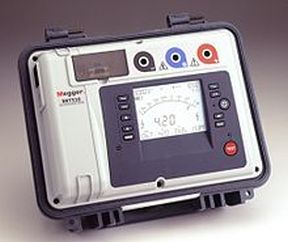When it comes to checking out electric motors, there are special measuring instruments that may be used to detect and diagnose malfunctions. The insulation resistance tester, generally known by its trade name Megger, is capable of providing critical information regarding the condition of motor insulation. In an industrial facility, the recommended procedure is to perform periodic tests and record the results so that damaging trends can be detected and corrected to prevent an outage and extensive downtime.
The insulation resistance tester resembles a conventional ohmmeter. But the Megger provides a much higher voltage rather than the ohm meter’s typical three-volt test voltage derived from an internal battery. (Some units may also incorporate a hand generator to produce high voltage levels. Others are designed to accept an input from a high-voltage source.) The Megger applies a voltage for a prescribed length of time. The leakage current through insulation, expressed as resistance, is displayed so it can be graphed. This test may take place on installing or on-the-reel cable, tools, appliances, transformers, power distribution subsystems, capacitors, motors and any type of electrical equipment or wiring.
 The test may be non-destructive for in-service equipment. A Megger can also apply elevated voltage for prolonged periods to prototypes under development until they fail to evaluate a proposed design. In using the Megger, a bit of a learning curve is involved. The correct settings, connection procedures, test durations and safety precautions must be implemented to avoid damaging the equipment or possible electrocutions.
The test may be non-destructive for in-service equipment. A Megger can also apply elevated voltage for prolonged periods to prototypes under development until they fail to evaluate a proposed design. In using the Megger, a bit of a learning curve is involved. The correct settings, connection procedures, test durations and safety precautions must be implemented to avoid damaging the equipment or possible electrocutions.
The motor under test must be powered down and disconnected from all equipment and wiring not included in the test. Besides invalidating the test, such extraneous equipment could be damaged by the applied voltage. Additionally, unsuspecting individuals could see hazardous electrical energy. This is because the applied voltages are of necessity high.
All wiring and equipment have an inherent amount of capacitance. And capacitance can be high in large motors. Because the equipment is effectively a storage capacitor, it is essential that lingering electrical energy is discharged before and after each test. To do this, shunt the relevant conductor(s) to the ground and to each other before reconnecting the power source. The unit should be discharged at least four times as long as the test voltage was applied.
The Megger is capable of applying different voltages, and the level should be coordinated with the type of equipment under test and the scope of the inquiry. The test is generally conducted by applying between 100 and 5,000 V or more. Operators must compose a protocol involving voltage level, time duration, intervals between tests and connection methods, taking into account the type and size of the equipment, its value and role in the production process and other factors.
A very valuable manual with the wonderful title “A Stitch in Time” is available at no cost at www.biddlemegger.com/biddle/Stitch-new.pdf. Another useful text is IEEE’s Recommended Practice for Testing Insulation Resistance of Rotating Machinery.

Leave a Reply
You must be logged in to post a comment.